Immunology/Inflammation
The immune and inflammation-related pathway including the Toll-like receptors pathway, the B cell receptor signaling pathway, the T cell receptor signaling pathway, etc.
Toll-like receptors (TLRs) play a central role in host cell recognition and responses to microbial pathogens. TLR4 initially recruits TIRAP and MyD88. MyD88 then recruits IRAKs, TRAF6, and the TAK1 complex, leading to early-stage activation of NF-κB and MAP kinases [1]. TLR4 is endocytosed and delivered to intracellular vesicles and forms a complex with TRAM and TRIF, which then recruits TRAF3 and the protein kinases TBK1 and IKKi. TBK1 and IKKi catalyze the phosphorylation of IRF3, leading to the expression of type I IFN [2].
BCR signaling is initiated through ligation of mIg under conditions that induce phosphorylation of the ITAMs in CD79, leading to the activation of Syk. Once Syk is activated, the BCR signal is transmitted via a series of proteins associated with the adaptor protein B-cell linker (Blnk, SLP-65). Blnk binds CD79a via non-ITAM tyrosines and is phosphorylated by Syk. Phospho-Blnk acts as a scaffold for the assembly of the other components, including Bruton’s tyrosine kinase (Btk), Vav 1, and phospholipase C-gamma 2 (PLCγ2) [3]. Following the assembly of the BCR-signalosome, GRB2 binds and activates the Ras-guanine exchange factor SOS, which in turn activates the small GTPase RAS. The original RAS signal is transmitted and amplified through the mitogen-activated protein kinase (MAPK) pathway, which including the serine/threonine-specific protein kinase RAF followed by MEK and extracellular signal related kinases ERK 1 and 2 [4]. After stimulation of BCR, CD19 is phosphorylated by Lyn. Phosphorylated CD19 activates PI3K by binding to the p85 subunit of PI3K and produce phosphatidylinositol-3,4,5-trisphosphate (PIP3) from PIP2, and PIP3 transmits signals downstream [5].
Central process of T cells responding to specific antigens is the binding of the T-cell receptor (TCR) to specific peptides bound to the major histocompatibility complex which expressed on antigen-presenting cells (APCs). Once TCR connected with its ligand, the ζ-chain–associated protein kinase 70 molecules (Zap-70) are recruited to the TCR-CD3 site and activated, resulting in an initiation of several signaling cascades. Once stimulation, Zap-70 forms complexes with several molecules including SLP-76; and a sequential protein kinase cascade is initiated, consisting of MAP kinase kinase kinase (MAP3K), MAP kinase kinase (MAPKK), and MAP kinase (MAPK) [6]. Two MAPK kinases, MKK4 and MKK7, have been reported to be the primary activators of JNK. MKK3, MKK4, and MKK6 are activators of P38 MAP kinase [7]. MAP kinase pathways are major pathways induced by TCR stimulation, and they play a key role in T-cell responses.
Phosphoinositide 3-kinase (PI3K) binds to the cytosolic domain of CD28, leading to conversion of PIP2 to PIP3, activation of PKB (Akt) and phosphoinositide-dependent kinase 1 (PDK1), and subsequent signaling transduction [8].
References
[1] Kawai T, Akira S. The role of pattern-recognition receptors in innate immunity: update on Toll-like receptors[J]. Nature immunology, 2010, 11(5): 373-384.
[2] Kawai T, Akira S. Toll-like receptors and their crosstalk with other innate receptors in infection and immunity[J]. Immunity, 2011, 34(5): 637-650.
[3] Packard T A, Cambier J C. B lymphocyte antigen receptor signaling: initiation, amplification, and regulation[J]. F1000Prime Rep, 2013, 5(40.10): 12703.
[4] Zhong Y, Byrd J C, Dubovsky J A. The B-cell receptor pathway: a critical component of healthy and malignant immune biology[C]//Seminars in hematology. WB Saunders, 2014, 51(3): 206-218.
[5] Baba Y, Matsumoto M, Kurosaki T. Calcium signaling in B cells: regulation of cytosolic Ca 2+ increase and its sensor molecules, STIM1 and STIM2[J]. Molecular immunology, 2014, 62(2): 339-343.
[6] Adachi K, Davis M M. T-cell receptor ligation induces distinct signaling pathways in naive vs. antigen-experienced T cells[J]. Proceedings of the National Academy of Sciences, 2011, 108(4): 1549-1554.
[7] Rincón M, Flavell R A, Davis R A. The Jnk and P38 MAP kinase signaling pathways in T cell–mediated immune responses[J]. Free Radical Biology and Medicine, 2000, 28(9): 1328-1337.
[8] Bashour K T, Gondarenko A, Chen H, et al. CD28 and CD3 have complementary roles in T-cell traction forces[J]. Proceedings of the National Academy of Sciences, 2014, 111(6): 2241-2246.
Targets for Immunology/Inflammation
- Apoptosis(303)
- 5-Lipoxygenase(18)
- Cyclic GMP-AMP Synthase(2)
- TLR(98)
- Papain(1)
- PGDS(1)
- PGE synthase(24)
- SIKs(10)
- IκB/IKK(62)
- AP-1(3)
- KEAP1-Nrf2(42)
- NOD1(1)
- NF-κB(240)
- Interleukin Related(147)
- 15-lipoxygenase(2)
- Others(10)
- Aryl Hydrocarbon Receptor(33)
- CD73(16)
- Complement System(52)
- Galectin(31)
- IFNAR(21)
- NO Synthase(75)
- NOD-like Receptor (NLR)(46)
- STING(101)
- Reactive Oxygen Species(446)
- FKBP(11)
- eNOS(5)
- iNOS(28)
- nNOS(20)
- Glutathione(54)
- Adaptive Immunity(216)
- Allergy(161)
- Arthritis(32)
- Autoimmunity(185)
- Gastric Disease(96)
- Immunosuppressants(37)
- Immunotherapeutics(5)
- Innate Immunity(579)
- Pulmonary Diseases(119)
- Reactive Nitrogen Species(54)
- Specialized Pro-Resolving Mediators(50)
- Reactive Sulfur Species(26)
- BCL6(0)
- CD20(0)
- CD22(0)
- CD28(0)
- PSMA(0)
- FAP(0)
Products for Immunology/Inflammation
- Cat.No. Nombre del producto Información
-
GC40202
7α-hydroxy Cholesterol-d7
7α-hydroxycholesterol-d7
7α-hydroxy Cholesterol-d7 is intended for use as an internal standard for the quantification of 7α-hydroxy cholesterol by GC- or LC-MS.

-
GC49206
7α-hydroxy Dehydroepiandrosterone
7α-hydroxy DHEA
An active metabolite of dehydroepiandrosterone
-
GC46740
7β,27-dihydroxy Cholesterol
7β,27-DHC
An oxysterol and agonist of RORγ and RORγt
-
GC52471
7(S),10(S)-DiHOME
DHOE, DOD
An antibacterial hydroxy fatty acid
-
GC46732
7(S),17(S)-dihydroxy-8(E),10(Z),13(Z),15(E),19(Z)-Docosapentaenoic Acid
7(S),17(S)hydroxy DPA
A metabolite of DPA with antiinflammatory properties
-
GC48769
7,10-dihydroxy-8(E)-Octadecenoic Acid
An antibacterial hydroxy fatty acid

-
GC46733
7,12-Dimethylbenz[a]anthracene
DMBA
7,12-Dimethylbenz[a]anthracene es un inmunosupresor y también un potente carcinógeno específico de órganos.![7,12-Dimethylbenz[a]anthracene Chemical Structure 7,12-Dimethylbenz[a]anthracene Chemical Structure](/media/struct/GC4/GC46733.png)
-
GC35184
7,3',4'-Tri-O-methylluteolin
La 7,3',4'-tri-O-metilluteolina (5-hidroxi-3',4',7-trimetoxiflavona), un compuesto flavonoide, posee potentes efectos antiinflamatorios en la lÍnea celular de macrÓfagos inducida por LPS mediada por la inhibiciÓn de liberaciÓn de mediadores inflamatorios, NO, PGE2 y citocinas proinflamatorias.

-
GC46080
7,3',4'-Trihydroxyflavone
3’,4’,7-Trihydroxyflavone, 5-Deoxyluteolin
7,3',4'-La trihidroxiflavona es un compuesto de aglicÓn flavonoide aislado de las vainas de habas.
-
GC35185
7,4'-Dihydroxyflavone
7,4'-DHF
La 7,4'-dihidroxiflavona (7,4'-DHF) es un flavonoide aislado de Glycyrrhiza uralensis, el inhibidor de eotaxina/CCL11, tiene la capacidad de suprimir constantemente la producciÓn de eotaxina y prevenir los efectos adversos paradÓjicos de la dexametasona (Dex) sobre la producciÓn de eotaxina. 1].
-
GC45673
7,8-Dihydroneopterin
D-erythro-7,8-Dihydroneopterin
La 7,8-dihidroneopterina, un marcador de inflamaciÓn, induce la apoptosis celular en astrocitos y neuronas a través de la mejora de la expresiÓn de Óxido nÍtrico sintasa (iNOS).
-
GC49887
7-(β-Hydroxyethyl)theophylline-d6
Etophylline-d6, Hydroxyethyltheophylline-d6
An internal standard for the quantification of 7-(β-hydroxyethyl)theophylline
-
GC45707
7-Azido-4-methylcoumarin
AzMC
A fluorescent H2S probe
-
GC40978
7-epi Maresin 1
7(S)MaR1, 7(S)Maresin 1
7-epi Maresin 1 is the inactive 7(S) epimer of Maresin 1, which contains a 7(R) hydroxyl group.
-
GC49312
7-Fluoro-2,1,3-benzoxadiazole-4-sulfonate (ammonium salt)
Ammonium 7-fluorobenzo-2-oxa-1,3-diazole-4-sulfonate, 7-Fluorobenzofurazan-4-Sulfonic Acid, SBD-F
El 7-fluoro-2,1,3-benzoxadiazol-4-sulfonato (sal de amonio) es un marcador fluorescente.
-
GC49051
7-hydroxy Methotrexate
NSC 380962, 7-hydroxy MTX
El 7-hidroxi metotrexato es un metabolito principal del metotrexato
-
GC42608
7-hydroxy Methotrexate (sodium salt)
7-hydroxy MTX
7-hydroxy Methotrexate (7-hydroxy MTX) is a phase I metabolite of MTX, which is converted by hepatic aldehyde oxidases.

-
GC46241
7-keto Cholesterol-d7
7-oxo Cholesterol-d7
7-keto Cholesterol is a bioactive sterol and a major oxysterol component of oxidized LDL

-
GC48880
7-Methoxyflavone
La 7-metoxiflavona es un compuesto aislado de Zornia brasiliensis.

-
GC13982
7-NINA
non-selective NOS inhibitor
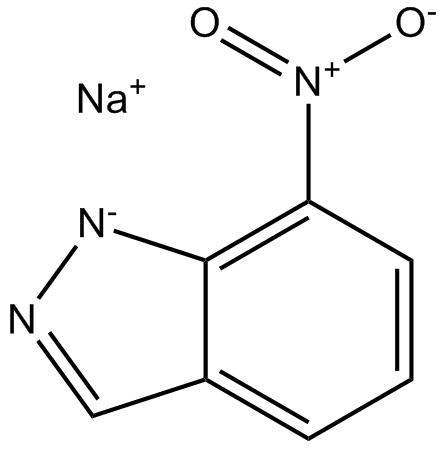
-
GC12309
7-Nitroindazole
El 7-nitroindazol es un inhibidor selectivo de la nNOS con efectos antinociceptivos y cardiovasculares.

-
GC71920
7-O-Methylaloesinol
7-O-Methylaloesinol es un derivado de cromone.
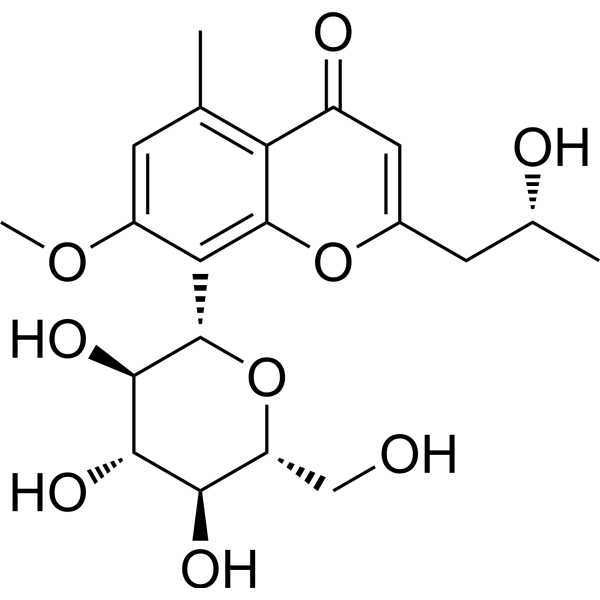
-
GC42616
7-oxo Staurosporine
BMY 41950, RK-1409
7-oxo Staurosporine is an antibiotic originally isolated from S.

-
GC52211
7-[1-(1H)-Tetrazolylacetamido]desacetoxycephalosporanic Acid
Cefazolin Impurity H
A potential impurity in commercial preparations of cefazolin![7-[1-(1H)-Tetrazolylacetamido]desacetoxycephalosporanic Acid Chemical Structure 7-[1-(1H)-Tetrazolylacetamido]desacetoxycephalosporanic Acid Chemical Structure](/media/struct/GC5/GC52211.png)
-
GC41136
8(S),15(S)-DiHETE
8(S),15(S)-DiHETE is formed when 15(S)-HETE is subjected to further oxidation by 15-LO.

-
GC42623
8-Bromoguanosine
2-Amino-8-bromo-6-hydroxypurine riboside, NSC 79211, NSC 174257
8-Bromoguanosine is a brominated derivative of guanosine.
-
GC35199
8-Deoxygartanin
8-Desoxigartanina, una xantonas preniladas de G.
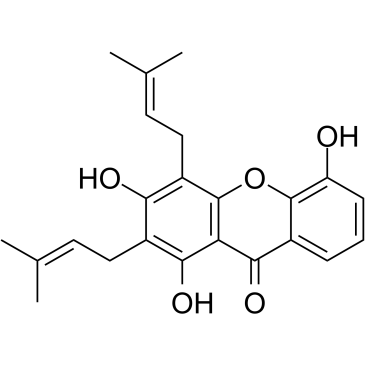
-
GC42627
8-Hydroxyguanine (hydrochloride)
NSC 22720, 8Oxoguanine
8-Hydroxyguanine is produced by oxidative degradation of DNA by hydroxyl radical.
-
GC18426
8-Nitroguanine
8-Nitroguanine is a nitrative guanine derivative formed by oxidative damage to the guanine base in DNA by reactive nitrogen species (RNS) during inflammation and in vitro by reaction of DNA with peroxynitrite and other RNS reagents.
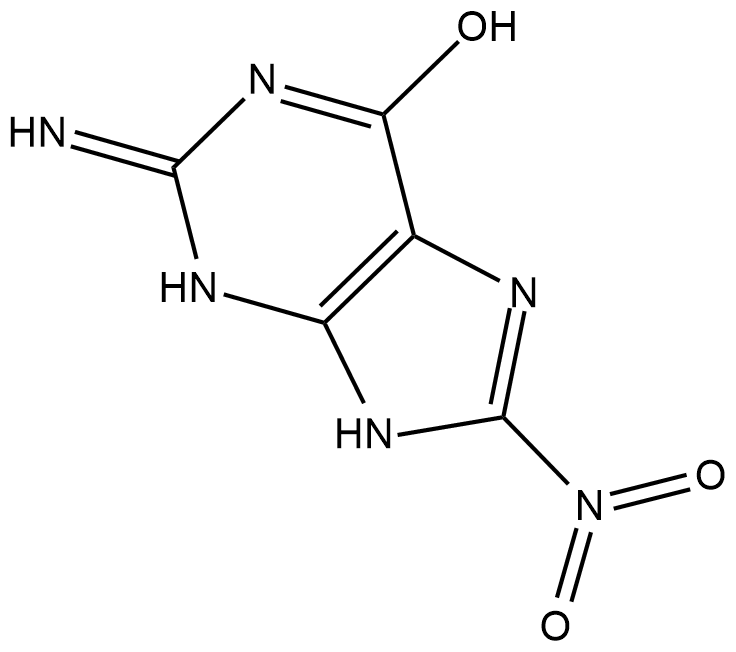
-
GN10212
8-O-Acetyl shanzhiside methyl ester

-
GC49275
8-Oxycoptisine
8-Oxocoptisine
La 8-oxicoptisina es un alcaloide de protoberberina natural con actividad anticancerÍgena.
-
GC46748
9(E),11(E)-12-nitro Conjugated Linoleic Acid
9(E),11(E)-12-nitro CLA, 12-NO2-CLA
A nitrated fatty acid
-
GC46749
9(E),11(E)-9-nitro Conjugated Linoleic Acid
9E,11E-9-nitro CLA
A nitrated fatty acid
-
GC42633
9(E)-Erythromycin A oxime
(9E)-Erythromycin A oxime is a metabolite of the semisynthetic antibiotic roxithromycin .

-
GC46753
9(S),12(S),13(S)-TriHOME
(–)-Pinellic Acid, 9S,12S,13S-Pinellic Acid
An oxylipin
-
GC40324
9(S)-PAHSA
9-PAHSA is a newly identified endogenous lipid that belongs to a collection of branched fatty acid esters of hydroxy fatty acids (FAHFAs).

-
GC46757
9(Z),11(E)-Conjugated Linoleic Acid (sodium salt)
cis-9,trans-11-Conjugated Linoleic Acid, 9(Z),11(E)-CLA
An isomer of linoleic acid
-
GC42642
9,10-Anthracenediyl-bis(methylene)dimalonic Acid
ABMDMA
El Ácido 9,10-antracenodiil-bis(metilen)dimalÓnico (ABMDMA) es un tinte biolÓgico y un indicador que se utiliza para detectar la generaciÓn de oxÍgeno singulete (SOG). El Ácido 9,10-antracenodiil-bis(metileno)dimalÓnico es un derivado soluble en agua del antraceno. El Ácido 9,10-antracenodiil-bis(metilen)dimalÓnico se puede fotoblanquear con oxÍgeno singulete a su endoperÓxido correspondiente. Esta reacciÓn se puede controlar espectrofotométricamente registrando la disminuciÓn de la absorbancia a 400 nm.
-
GC70659
9-cis-Retinoic acid-d5
9-cis-Retinoic acid-d5 es el deuterio etiquetado como ácido 9-cis-retinoico.

-
GC42644
9-Deazaguanine
NSC 344522
9-Deazaguanine is an analog of guanine that acts as an inhibitor of purine nucleoside phosphorylase (PNP; Kd = 160 nM).
-
GC42648
9-Methylstreptimidone
Antibiotic TS 885, NSC 248958
9-Methylstreptimidone is a microbial metabolite originally isolated from Streptomyces sp.
-
GC42649
9-Nitrooleate
9Nitrooleic Acid, 9nitro9transOctadecenoic Acid
Nitrated unsaturated fatty acids, such as 10- and 12-nitrolinoleate, cholesteryl nitrolinoleate, and nitrohydroxylinoleate, represent a new class of endogenous lipid-derived signalling molecules.
-
GC42653
9-OxoOTrE
9KOTE, 9KOTrE
9-OxoOTrE is produced by the oxidation of 9-HpOTrE.
-
GC40325
9-PAHSA
Branched fatty acid esters of hydroxy fatty acids (FAHFAs) are newly identified endogenous lipids regulated by fasting and high-fat feeding and associated with insulin sensitivity.

-
GC49237
93-O17O
A cationic lipidoid

-
GC49238
93-O17S
A cationic lipidoid

-
GC45960
9c(i472)
15-LOX-1 Inhibitor i472
9c(i472) es un potente inhibidor de 15-LOX-1 (15-lipoxigenasa-1) con un valor IC50 de 0,19 μM.
-
GC45930
A 26771B
A macrolide antibiotic

-
GC42660
A-39183A
A-39183A is an active component of the A-39183 antibiotic complex produced by aerobic fermentation of Streptomyces NRRL 12049.

-
GC42661
A-54556B
A-54556 Factor B
A-54556B is a natural acyldepsipeptide (ADEP) antibiotic isolated from the fermentation broth of S.
-
GC18936
A-83016F
Antibiotic A-83016F
A-83016F is an aurodox antibiotic isolated from the actinomycete species A83016.
-
GC49309
A-943931 (hydrochloride hydrate)
A histamine H4 receptor antagonist

-
GC35214
A-9758
A-9758 es un ligando de RORγ y un potente agonista inverso de RORγt selectivo (CI50 = 5 nM), y exhibe una potencia robusta contra la liberaciÓn de IL-17A.

-
GP10060
a-MSH, amide
Ac-Ser-Tyr-Ser-Met-Glu-His-Phe-Arg-Trp-Gly-Lys-Pro-Val-amide, α-MSH, amide
La a-MSH (hormona alfa-melanocito estimulante), amida, se une al receptor de melanocortina-1 y activa la señalización del AMP cíclico (cAMP) a través de un transportador de proteína G, lo que puede sintetizar melanina.

-
GC19496
AAPH
AAPH is a water-soluble azo compound

-
GC42666
AAT-008
AAT-008 es un antagonista del receptor de prostaglandina EP4 potente, selectivo y activo por vÍa oral con Kis de 0,97 y 6,1 nM para EP4 humano recombinante y EP4 de rata recombinante, respectivamente.

-
GC65293
AB-680
AB-680 es un inhibidor altamente potente, reversible y selectivo de CD73 (una ectonucleotidasa), con una Ki de 4,9 pM para hCD73, muestra una selectividad >10 000 veces sobre las ectonucleotidasas relacionadas CD39. Actividad antitumoral.

-
GC42667
Abacavir Carboxylate
Abacavir carboxylate is an inactive metabolite of the HIV-1 reverse transcriptase inhibitor abacavir.

-
GC46767
Abacavir-d4
An internal standard for the quantification of abacavir

-
GC49766
Abafungin
BAY-W 6341
La abafungina, un agente antifÚngico, inhibe la transmetilaciÓn en la posiciÓn C-24 de la cadena lateral del esterol, catalizada por la enzima esterol-C-24-metiltransferasa.
-
GC42668
ABC34
ABC34 is an inactive control probe for JJH260, the inhibitor of androgen-induced gene 1 (AIG1), an enzyme that hydrolyzes fatty acid esters of hydroxy fatty acids (FAHFAs).

-
GC68595
Abrezekimab
UCB4144; VR 942
Abrezekimab (VR 942) contains CDP7766, which is a humanized, high-affinity, neutralizing anti-human IL-13 antibody fragment that can bind to IL-13. Abrezekimab blocks the binding of IL-13 to the IL-13Rα1 subunit. Abrezekimab can be used for research on asthma.

-
GC49745
ABT-263-d8
Navitoclax-d8
ABT-263-d8 es el deuterio etiquetado como Navitoclax. Navitoclax (ABT-263) es un inhibidor de proteÍnas de la familia Bcl-2 potente y activo por vÍa oral que se une a mÚltiples proteÍnas de la familia Bcl-2 antiapoptÓticas, como Bcl-xL, Bcl-2 y Bcl-w, con un Ki de menos de 1 nM.
-
GC70733
ABT-510 acetate
ABT-510 acetate es un péptido antiangitsp (análogo de la tromboespondina 1) que induce apoptosis e inhiel crecimiento de tumores ovárien un modelo ortotópico y singénico de cáncer de ovariepiteli.
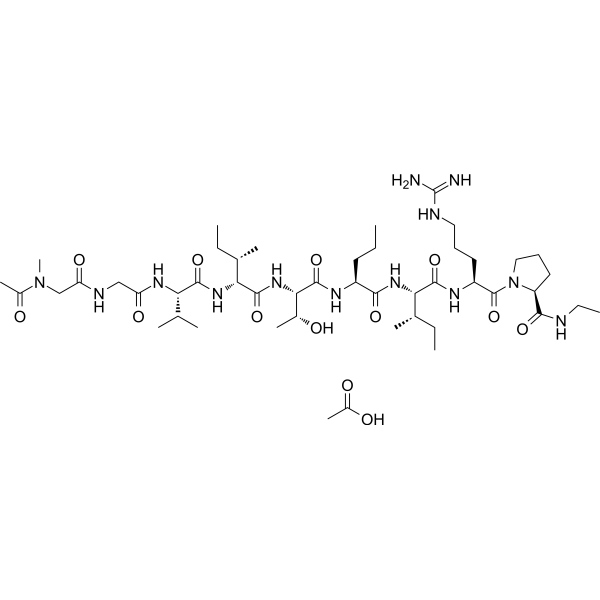
-
GC42683
Abz-Ala-Pro-Glu-Glu-Ile-Met-Arg-Arg-Gln-EDDnp
Abz-Ala-Pro-Glu-Glu-Ile-Met-Arg-Arg-Gln-EDDnp is a fluorescence-quenched peptide substrate for human neutrophil elastase (kcat/Km = 531 mM-1s-1).

-
GC52499
Abz-Ala-Pro-Glu-Glu-Ile-Met-Arg-Arg-Gln-EDDnp (trifluoroacetate salt)
A sensitive substrate for neutrophil elastase

-
GC42684
Abz-Val-Ala-Asp-Nva-Arg-Asp-Arg-Gln-EDDnp (trifluoroacetate salt)
Abz-Val-Ala-Asp-Nva-Arg-Asp-Arg-Gln-EDDnp is a fluorescence-quenched peptide substrate for human proteinase 3 (kcat/Km = 1,570 mM-1s-1).

-
GC42685
Ac-ANW-AMC
Ac-Ala-Asn-Trp-AMC
Ac-ANW-AMC es un sustrato fluorogénico para el inmunoproteasoma.
-
GC49704
Ac-FLTD-CMK (trifluoroacetate salt)
Ac-Phe-Leu-Thr-Asp-CMK
An inhibitor of caspase-1, -4, -5, and -11
-
GA20621
Ac-muramic acid
MurNAc
Un componente de las paredes celulares bacterianas. Para un derivado protegido de MurNAc, consulte Q-1005.
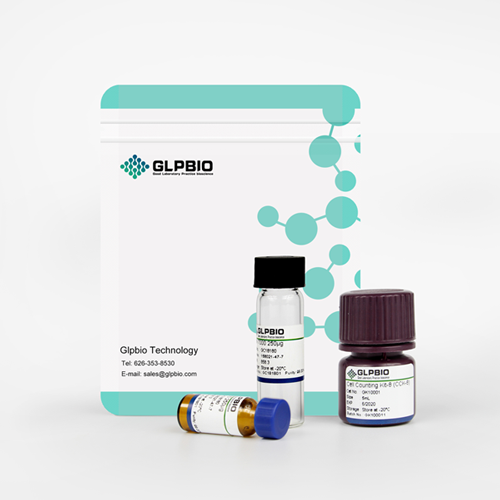
-
GC52372
Ac-VDVAD-AFC (trifluoroacetate salt)
N-Acetyl-Val-Asp-Val-Ala-Asp-AFC, N-Acetyl-Val-Asp-Val-Ala-Asp-7-amino-4-Trifluoromethylcoumarin, Caspase-2 Substrate (Fluorogenic)
A fluorogenic substrate for caspase-2
-
GC15598
Ac2-26
Ac2-26, un péptido N-terminal activo de la anexina A1 (AnxA1), atenÚa la lesiÓn pulmonar aguda inducida por isquemia-reperfusiÓn.

-
GC49263
Ac2-26 (human) (ammonium salt)
Ac-AMVSEFLKQAWFIENEEQEYVQTVK-OH, Ac-ANX-A12-26, N-Acetyl-AMVSEFLKQAWFIENEEQEYVQTVK
An annexin A1-mimetic peptide
-
GC35224
Ac2-26 TFA
Ac2-26 TFA, un péptido N-terminal activo de la anexina A1 (AnxA1), atenÚa la lesiÓn pulmonar aguda inducida por isquemia-reperfusiÓn.
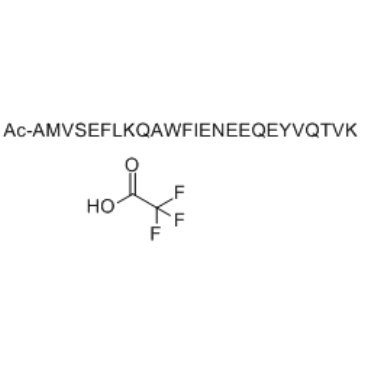
-
GC42691
Aceclofenac ethyl ester
A potential impurity found in commercial preparations of aceclofenac

-
GC42692
Aceclofenac methyl ester
Aceclofenac Impurity D
A potential impurity in commercial preparations of aceclofenac
-
GC49911
Acetyl Hexapeptide-38 (trifluoroacetate salt)
A hexapeptide

-
GC42700
Acetyl Pentapeptide-1
Acetyl pentapeptide-1 is a pentapeptide that decreases IL-8 secretion in human keratinocytes when used in combination with acetyl hexapeptide-36 and acetyl hexapeptide-38.

-
GC18443
Acetyl-6-formylpterin
Ac-6-FP, 2-Acetamido-6-formylpteridin-4-one, NSC 129965
Acetyl-6-formylpterin is an inhibitor of mucosal-associated invariant T (MAIT) cell activation.
-
GC11786
Acetylcysteine
N-acetylcysteine; N-acetyl-L-cysteine; NAC; Acetadote
Acetylcysteine es el derivado N-acetil de la CISTEÍNA.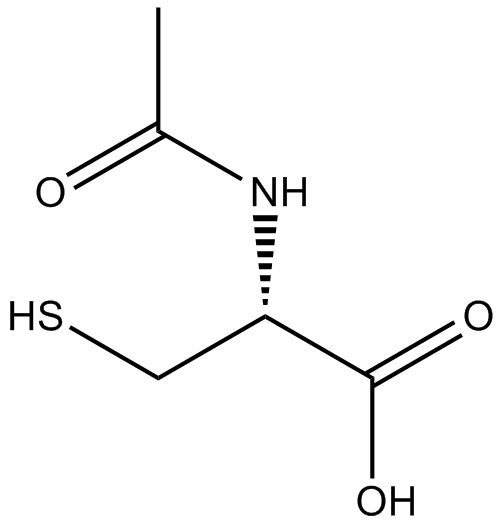
-
GC17416
ACHP
IκB kinase inhibitor

-
GN10536
Aconine
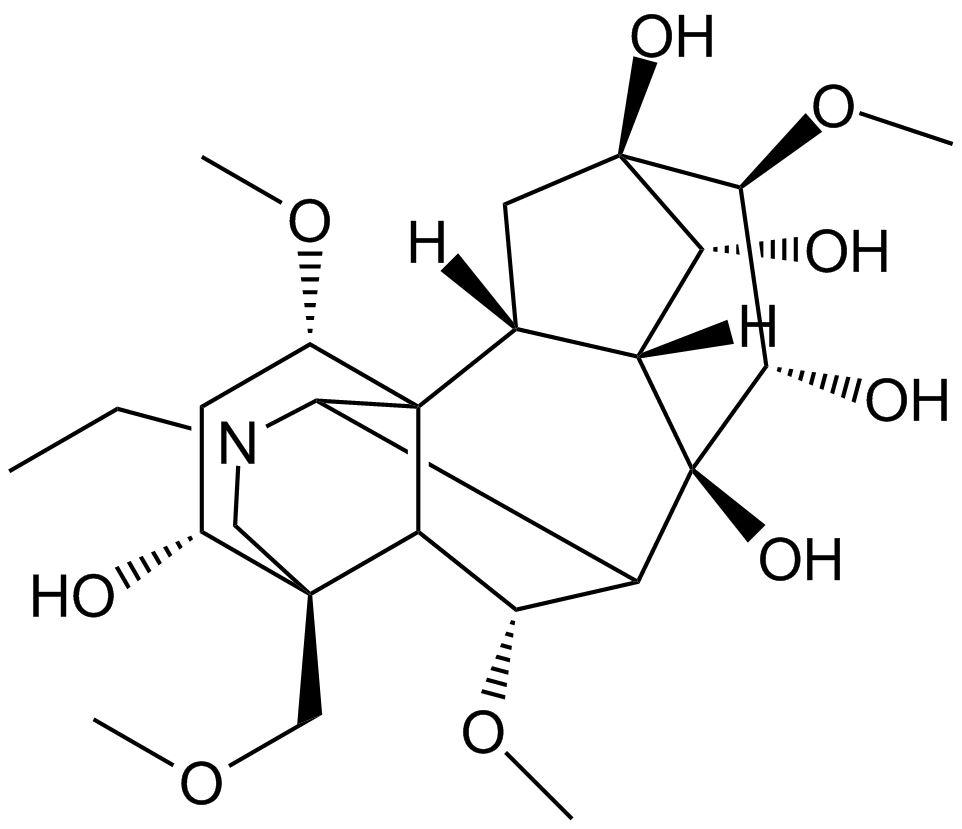
-
GC49804
Acridine
2,3,5,6-Dibenzopyridine, 10-Azaanthracene, Dibenzopyridine, NSC 3408
An azaarene
-
GC40645
Actarit
4-Acetylaminophenylacetic Acid, MS-932, NSC 170317
Actarit, un compuesto antirreumÁtico activo por vÍa oral, tiene el potencial para tratar la artritis inducida por colÁgeno tipo II.
-
GC70584
Actinomycin X2
Actinomycin X2 (actinomicina V), producido por muchos Streptomyces sp.
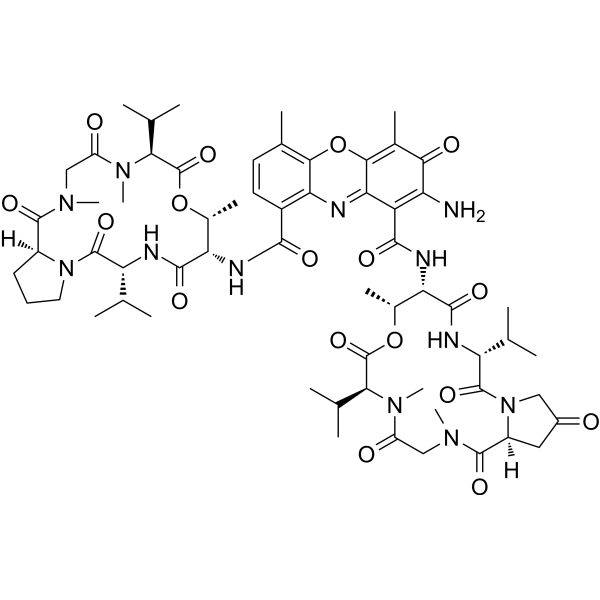
-
GC41316
Actinopyrone A
(+)-Actinopyrone A, SS 1538A
Actinopyrone A is a pyrone isolated from S.
-
GC48842
Actiphenol
Actinophenol, NSC 58413
A bacterial metabolite with antiviral activity
-
GC46797
Acyclovir-d4
ACV-d4
An internal standard for the quantification of acyclovir
-
GC46798
Adapalene-d3
An internal standard for the quantification of adapalene

-
GC46805
Adefovir-d4
PMEA-d4
An internal standard for the quantification of adefovir
-
GC31693
Adelmidrol
Adelmidrol ejerce importantes efectos antiinflamatorios que dependen en parte de PPARγ.

-
GC49285
Adenosine 5’-methylenediphosphate (hydrate)
Adenosine 5'-(α,β-methylene)diphosphate, AMP-CP, APCP, 5'-APCP
An inhibitor of ecto-5’-nucleotidase
-
GC60040
ADH-503
(Z)-Leukadherin-1 choline
ADH-503 ((Z)-Leukadherin-1 choline) es un agonista de CD11b alostérico activo por vÍa oral. ADH-503 conduce a la repolarizaciÓn de los macrÓfagos asociados al tumor, la reducciÓn del nÚmero de células mieloides inmunosupresoras que infiltran el tumor y mejora las respuestas de las células dendrÍticas.
-
GC71405
ADS032
ADS032 es un inhibidual de NLRP1 y NLRP3 que puede rápida, reversible y estable inhibir la formación de inflammasoma.
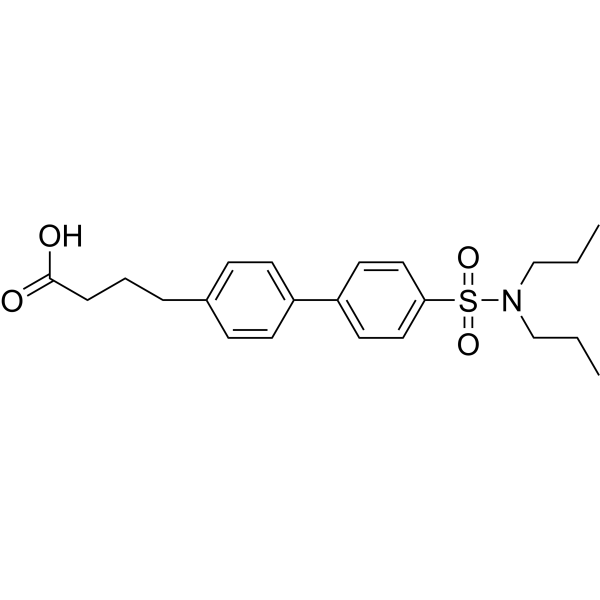
-
GC42742
ADT-OH
ACS1
ADT-OH es un donante liberador de sulfuro de hidrÓgeno. ADT-OH induce la apoptosis e inhibe el desarrollo de melanoma in vivo mediante la regulaciÓn positiva de FADD. ADT-OH tiene potencial para la investigaciÓn de enfermedades cancerosas.
-
GC31649
ADU-S100 (ML RR-S2 CDA)
MIW815; ML RR-S2 CDA
ADU-S100 (ML RR-S2 CDA) (MIW815), un activador del estimulador de genes de interferÓn (STING), conduce a una regresiÓn e inmunidad tumoral potente y sistémica.
-
GC39161
ADU-S100 disodium salt
MIW815 disodium salt; ML RR-S2 CDA disodium salt
La sal disÓdica ADU-S100 (sal disÓdica MIW815) es un activador del estimulador de genes de interferÓn (STING).
-
GC42743
AEM1
AEM1 es un inhibidor de Nrf2. AEM1 reduce las expresiones de genes dependientes de Nrf2 en células A549 e inhibe el crecimiento de células A549 in vitro e in vivo.

-
GC63485
Afimetoran
BMS-986256
Afimetoran es un antagonista del receptor tipo toll, que se puede utilizar en la investigaciÓn de enfermedades inflamatorias y autoinmunes.
-
GC66396
Agatolimod
ODN 2006; CpG 7909; PF-3512676
Agatolimod (ODN 2006), un ODN (oligodesoxinucleÓtido) de clase B, es un agonista de TLR9. Agatolimod también es una secuencia CpG Óptima para humanos. Agatolimod estimula una producciÓn muy fuerte de NO2 e IL-6 en las células HD11. Agatolimod se puede utilizar para la investigaciÓn del cÁncer de mama. Secuencia: 5'-tcgtcgttttgtcgttttgtcgtt-3'.


